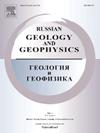伊加尔卡隆起的前寒武纪-寒武纪过渡期(西伯利亚西北地台)
IF 1
4区 地球科学
Q3 GEOSCIENCES, MULTIDISCIPLINARY
引用次数: 1
摘要
--前寒武纪-寒武纪的转变是地球历史上最基本的进化转折之一。然而,在许多情况下,即使应用了全谱的生物地层学和化学地层学方法,在岩性对比剖面中精确识别和对比这一关键边界也是复杂的。Igarka隆起的前寒武纪-寒武纪过渡地层(Sukharikha组)完美地说明了这一问题。该单元可以说是该时间段(至少在西伯利亚地台内)最详细的碳酸盐-碳同位素曲线之一。然而,先前报道的苏哈里卡组的古生物学记录极其糟糕,这使得主要地层边界的确定极具争议。我们详细研究了三个区段(Sukharikha河、Kulyumbe河和Khantaisko-Sukhotungusskaya-1井)的Sukharika和上覆Krasnyi Porog地层。我们的化学地层学和生物地层学数据为这些剖面提供了对比基础,并根据国际年代地层图和俄罗斯一般地层尺度确定了寒武纪边界。我们表明,在Igarka古盆地内,Tommotian小型骨骼化石局部首次出现的岩性边界和水平是跨时的。后者被认为是由早寒武纪生物群的古生态学和地震学因素引起的。我们的数据规定了西伯利亚地台其他关键的前寒武纪-寒武纪过渡段中汤莫提阶(senso-lato)/寒武纪2阶边界的位置。本文章由计算机程序翻译,如有差异,请以英文原文为准。
Precambrian–Cambrian Transition at the Igarka Uplift (Northwestern Siberian Platform)
—The Precambrian–Cambrian transition is one of the most fundamental evolutionary turnovers in the Earth’s history. However, in many cases precise identification and correlation of this crucial boundary in lithologically contrasting sections is complicated, even if the whole spectrum of biostratigraphic and chemostratigraphic methods is applied. The Precambrian–Cambrian transitional strata of the Igarka Uplift (Sukharikha Formation) perfectly illustrate this problem. This unit has arguably one of the most detailed carbonate carbon isotope curves for this time interval (at least within the Siberian Platform). However, an extremely poor paleontological record previously reported from the Sukharikha Formation makes identification of major stratigraphic boundaries highly debatable. We present a detailed study of the Sukharikha and overlying Krasnyi Porog formations in three sections (Sukharikha River, Kulyumbe River, and Khantaisko-Sukhotungusskaya-1 well). Our chemostratigraphic and biostratigraphic data provide a correlation basis for these sections and identify the Cambrian boundary in terms of both the International Chronostratigraphic Chart and General Stratigraphic Scale of Russia. We show that lithologic boundaries and levels of the local first appearance of Tommotian small skeletal fossils are diachronous within the Igarka paleobasin. The latter is putatively caused by paleoecology of the early Cambrian biota and by taphonomic factors. Our data specify the location of the Tommotian Stage (sensu lato)/Cambrian Stage 2 boundary in other key Precambrian–Cambrian transitional sections of the Siberian Platform.
求助全文
通过发布文献求助,成功后即可免费获取论文全文。
去求助
来源期刊

Russian Geology and Geophysics
地学-地球科学综合
CiteScore
2.00
自引率
18.20%
发文量
95
审稿时长
4-8 weeks
期刊介绍:
The journal publishes original reports of theoretical and methodological nature in the fields of geology, geophysics, and geochemistry, which contain data on composition and structure of the Earth''s crust and mantle, describes processes of formation and general regularities of commercial mineral occurrences, investigations on development and application of geological-geophysical methods for their revealing. As to works of regional nature, accelerated publication are available for original papers on a variety of problems of comparative geology taking into account specific character of Siberia, adjacent Asian countries and water areas. The journal will also publish reviews, critical articles, chronicle of the most important scientific events, and advertisements.
 求助内容:
求助内容: 应助结果提醒方式:
应助结果提醒方式:


